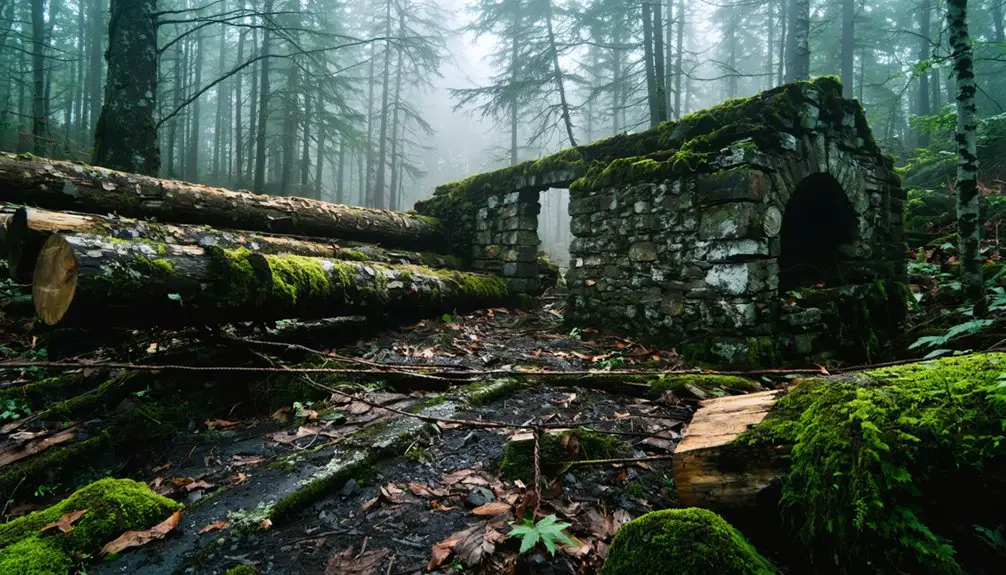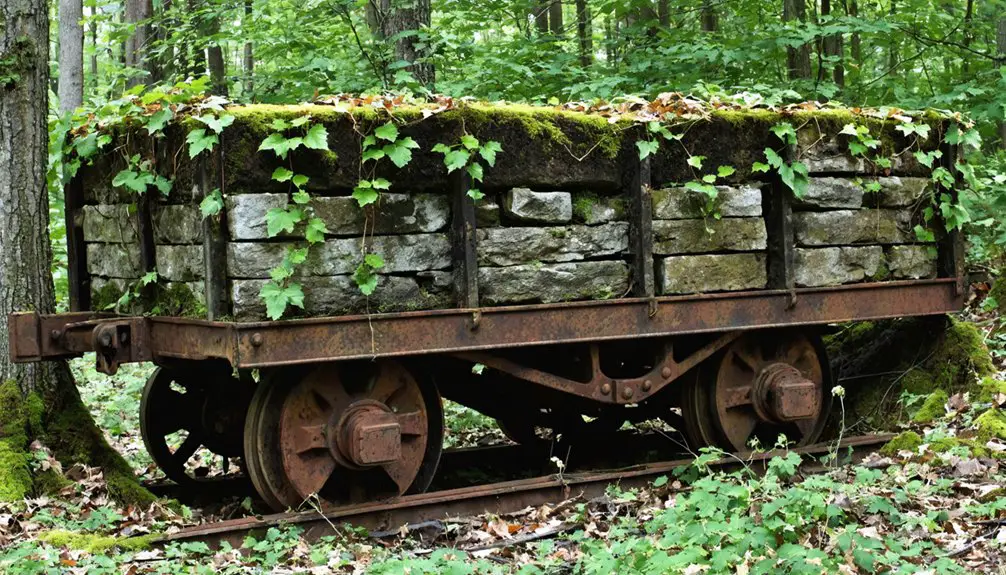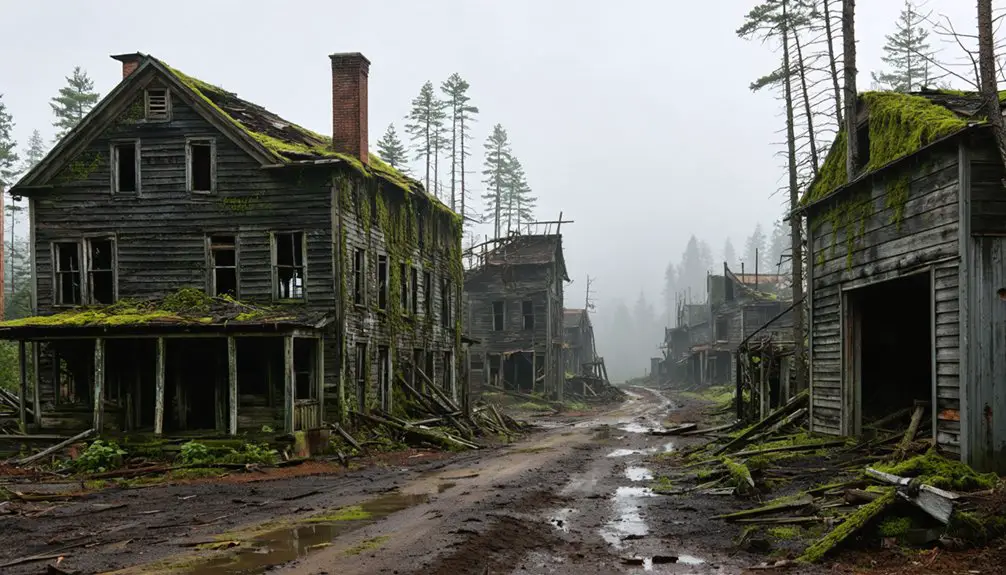You’ll find the ghost town of Masten nestled in Pennsylvania’s dense forests, where a bustling lumber community of 1,000 residents once thrived. Established in 1906 by Charles W. Sones, the town centered around sawmills and a clothespin factory, with workers living in company-owned homes. After the Central Pennsylvania Lumber Company acquired the mills in 1917, intensive logging depleted the forests by 1930. Today, preserved ruins and historical records tell the story of this vanished industrial settlement.
Key Takeaways
- Masten transformed from a thriving lumber town of 1,000 residents in the early 1900s to a ghost town after mills closed in 1930.
- The town featured sawmills, a clothespin factory, and 20 duplex homes that supported about 40 workers and their families.
- After the local timber resources were depleted through clear-cutting, the town’s primary economic foundation collapsed, leading to abandonment.
- A brief revival occurred when the Civilian Conservation Corps established a camp from 1933 to 1940.
- Today, Masten exists only through preserved artifacts, historical documentation, and remnants of its industrial past.
The Birth of a Lumber Town
When the Pennsylvania lumber industry was booming in the early 1900s, Charles W. Sones established Masten in 1906, carving out a new settlement amid the region’s dense forests.
You’ll find that Sones’s vision for this lumber town began with the construction of the first sawmill, setting the foundation for what would become a thriving industrial hub.
The town infrastructure emerged specifically to support lumber operations, reflecting the untamed spirit of Pennsylvania’s forestlands.
Masten’s rugged infrastructure embodied the raw essence of Pennsylvania’s wilderness, purpose-built to serve the demanding timber trade.
As you explore Masten’s origins, you’ll discover how this strategic location positioned the settlement perfectly for timber harvesting and processing.
The town’s establishment came at a pivotal moment when the lumber industry dominated the state’s economy, making Masten a symbol of American resourcefulness and industrial freedom in the early twentieth century.
The town remained active until early 1930s, showcasing the rise and fall of Pennsylvania’s lumber era.
The settlement grew to include two sawmills, a clothespin factory, and a lath mill that supported its expanding industrial operations.
Life in Early Masten
Life within Masten’s borders reflected the rhythms of a bustling lumber town, where nearly 1,000 residents built their lives around the steady hum of sawmills and the clothespin factory.
You’d find workers’ families settled in company-owned homes near the mills, their daily routines shaped by the seasonal nature of lumber production.
Community dynamics centered on shared labor experiences, with workers spending long hours at the mills while their children attended the local school.
You’d notice strong bonds forming through informal gatherings, as neighbors relied on each other in this isolated setting. Like early Warren settlers, residents often gathered at the local taverns to socialize and build community ties.
The town saw a brief resurgence when a Civilian Conservation Corps camp operated there from 1933 to 1940.
Labor relationships defined much of the social structure, with the company store providing necessities and the logging railroad serving as your lifeline to the outside world.
Despite basic living conditions, residents forged resilient connections that sustained their remote community.
Industrial Development and Peak Years
Founded in 1906 by Charles Sones, Masten quickly evolved into a thriving industrial hub centered around its pioneering sawmill operations. The mill’s final day of operation came when the last log processed was cut on September 18, 1930.
Similar to the lumber industry’s impact documented at the Pennsylvania Lumber Museum, the town’s lumber production and economic dependency on the mills shaped every aspect of daily life until 1930. You’ll find that the Central Pennsylvania Lumber Company took control in 1917, continuing operations that supported the region’s development.
If you’d ventured to Masten during its peak, you’d have witnessed:
- Massive log ponds with timber awaiting processing through state-of-the-art edger saws
- The bustling Susquehanna & New York Railroad transporting finished lumber to market
- Workers’ families living in close-knit community housing near the mills
- A network of industrial facilities designed to maximize production in the rugged terrain
The Central Pennsylvania Lumber Company Era
The Central Pennsylvania Lumber Company‘s acquisition of Masten’s mills in 1917 marked a significant new chapter in the town’s industrial story.
You’ll find that CPL, headquartered in Ridgway, invested $50,000 in capital stock to continue the logging operations established by Charles W. Sones. Their logging techniques reflected the era’s standard practices, employing edger saw technology and clear-cutting methods throughout the dense Pennsylvania forests. Historic footage from 1926 near Sheffield showcases these intensive logging operations in detail. The company’s operations became part of Pennsylvania’s rich lumber heritage, which continues to influence modern forestry management.
As you explore the economic trends of this period, you’ll notice how CPL’s presence sustained local employment until 1930, processing timber for construction and other industries.
However, when CPL ceased operations that year, Masten’s fate was sealed. The once-bustling mill town gradually emptied, its decline captured in photographs and film footage now preserved in museum collections, telling the story of Pennsylvania’s lumber heritage.
Daily Life and Community Structure
If you’d lived in Masten during its lumber boom, you’d have found yourself in one of the company-built wooden homes clustered near the mills, where workers and their families formed tight-knit neighborhoods.
Your social life would’ve centered around informal gatherings and company-sponsored events, with limited formal entertainment options but strong community bonds forged through shared work experiences.
While details about schools and churches remain sparse in historical records, the town’s transient worker population and industrial focus suggest that formal institutions played a minimal role in daily life.
Workers’ Housing and Amenities
Life in Masten revolved around company-built housing, where approximately 40 carefully selected workers and their families occupied 20 durable duplex homes constructed during the 1920s.
Similar to the coal industry decline that plagued many Pennsylvania towns, Masten’s population eventually dropped to just a fraction of its peak numbers.
The worker housing reflected the company’s tight control over residents’ lives, with allocation tied directly to employment contracts, including restrictive “yellow dog” agreements that banned union membership.
Located near Pleasant Stream Road, Masten served as both a logging town and sawmill operation that supported the region’s timber industry.
Your daily existence in Masten’s worker housing meant dealing with:
- Primitive communal sanitation facilities
- Limited potable water that often required delivery
- Wood or coal heating systems tied to local resource extraction
- Basic road networks connecting homes to work sites
Despite these austere conditions, you’d find the homes strategically positioned near schools, churches, and essential community amenities, though most supplies required travel beyond town limits.
Social Activities and Gatherings
Beyond the confines of company housing, social bonds in Masten flourished through organized gatherings at mills and factory spaces. You’d find workers and their families congregating around the clothespin and lath mills, sharing community meals during breaks and celebrating company milestones.
The town’s social structure revolved around these industrial hubs, where informal recreational sports and outdoor games took place on cleared land near residential areas.
After work hours, you could join storytelling sessions or music gatherings, particularly during seasonal festivities. While men spent long hours logging, women maintained domestic networks, creating mutual support systems for times of hardship.
The railroad’s regular schedule brought visitors and news, connecting you to the wider world beyond Masten’s forested boundaries. Local stores and trading posts served as vibrant social centers for daily interactions.
Education and Religious Life
Education in Masten followed patterns typical of Pennsylvania lumber towns, with no formal schoolhouse established within the community. Educational practices likely took place in multi-purpose buildings, while nearby towns provided additional schooling options for the children of lumber workers.
Religious gatherings played a crucial role in maintaining community bonds, with Protestant services bringing residents together weekly.
You’ll find that religion shaped daily life in Masten through:
- Sunday services that offered respite from demanding lumber work
- Church halls that doubled as community meeting spaces
- Religious leaders who served as social mediators
- Seasonal celebrations that structured the town’s calendar
While no physical church buildings remain today, the spiritual legacy of Masten’s religious life echoes through regional historical accounts and parallels with neighboring lumber communities.
The Environmental Impact of Logging

If you’d visited Masten’s forests between 1906 and 1930, you’d have witnessed the systematic clear-cutting of old-growth timber that stripped the landscape bare.
The rapid depletion of forest resources followed a predictable pattern: loggers would exhaust one section before moving to adjacent stands, leaving behind exposed soil vulnerable to erosion and disrupted wildlife habitats.
After the mill’s closure in 1930, the abandoned land began a slow process of natural regeneration, though the forest composition would never fully match its original old-growth character.
Forest Depletion Patterns
During the peak of Pennsylvania’s railroad logging era from 1890 to 1930, Masten witnessed one of the most dramatic environmental transformations in the state’s history.
Without logging regulations in place, timber companies stripped the landscape bare, leaving little chance for natural forest regeneration.
You’ll find the devastating patterns of deforestation were marked by:
- Steam-powered locomotives penetrating virgin forests that were previously untouched
- Complete removal of all tree species and sizes, creating the infamous “Allegheny Brush Pile”
- Widespread erosion and stream sedimentation from exposed soils
- Chemical factories processing every usable scrap of wood into charcoal, alcohol, and tar
The industrial-scale operations didn’t just take the valuable timber – they transformed entire ecosystems, leaving behind a barren landscape that would take decades to recover.
Recovery After Mill Closure
While logging operations devastated Masten’s landscape through the 1920s, the mill’s closure triggered a remarkable environmental recovery process that you can still witness today.
After the shutdown, you’ll find the area underwent a dramatic transformation as the Civilian Conservation Corps converted former industrial sites into public recreational spaces. The forest’s natural resilience became evident through mixed-species regeneration, which enhanced biodiversity after years of single-species logging.
You’ll notice how sustainable forestry practices now promote faster carbon absorption through new growth, while strict environmental regulations protect streams from siltation.
Though the mill closure initially devastated Masten’s economy, it forced economic diversification in the region’s timber industry, leading to more sustainable practices and varied forest product usage that better preserve the landscape.
The Final Years and Abandonment
Although Masten had thrived as a bustling lumber mill town since 1906, the Central Pennsylvania Lumber Company‘s decision to cease operations in 1930 marked the beginning of its swift decline.
As employment opportunities vanished, families were forced to seek work elsewhere, leading to the final decline of this once-vibrant community.
Today, you’ll find only ghostly remnants of Masten’s past, with these stark reminders of its transformation:
- Abandoned mill equipment, now preserved in museums
- Former railroad grades converted to hiking trails within the Old Loggers Path
- Crumbling foundations where homes and community buildings once stood
- Wilderness reclaiming the industrial sites where lumber processing once dominated
What Remains Today

Present-day visitors to Masten’s ruins encounter only scattered remnants of its industrial past. You’ll find old foundations, concrete slabs, and traces of the railroad that once served the town’s sawmills and coal operations.
Nature has reclaimed most of the site, with dense forest surrounding the ruins along Pleasant Stream. While the Stone Church stands nearby in White Deer Valley, Masten proper contains no intact structures.
The ghost town’s archaeological significance lies in its industrial footprint – remnants of two sawmills, a clothespin factory, and a lath mill dot the landscape.
If you’re planning to explore, you’ll need local knowledge to navigate the rugged terrain. The site’s remote location in Lycoming County has preserved these artifacts from vandalism, though forest growth continues to obscure these fascinating pieces of Pennsylvania’s lumber heritage.
Historical Preservation and Documentation
Thanks to dedicated preservation efforts, Masten’s rich history lives on through various institutional and individual initiatives. The Pennsylvania Lumber Museum and Taber Museum lead preservation strategies by maintaining historical artifacts, photographs, and machinery from the town’s heyday.
David L. Richards’ thorough book “Masten: Lumber Giant” serves as a cornerstone of documentation.
You’ll find these key preservation elements:
- Original edger saw components from Masten’s mills
- Photo postcards donated by former residents’ descendants
- Digital archives accessible through genealogy websites
- Machinery parts displayed in museum collections
Despite limited physical remains, you can explore Masten’s story through museum exhibits, educational programs, and historical lectures.
Community partnerships and institutional support guarantee this ghost town’s legacy continues to educate and inspire future generations.
Frequently Asked Questions
Are There Any Paranormal Activities Reported in the Abandoned Town of Masten?
You’ll find documented ghost sightings in Yellow Dog Village’s abandoned buildings, where spirits communicate with visitors. Unexplained noises and EVP recordings suggest family presences lingering from the town’s lumber mill era.
Can Visitors Legally Explore the Masten Site Today?
Through the misty ruins of yesteryear, you can’t legally explore Masten’s site without permission – it’s on private property. Current regulations require landowner approval before visiting these historic grounds.
What Happened to the Machinery and Equipment After the Mills Closed?
You’ll find most machinery was salvaged, sold, or scrapped after 1930. Some equipment relocated to other mills, while specific pieces like the edger saw found preservation in local museums.
Did Any Former Residents Attempt to Revive the Town After 1941?
You won’t find any documented residential efforts to revive the town after 1941. Historical records show no attempts by former residents, with preservation focused on museums and historical writings instead of town revival.
Were There Any Churches or Schools Established During Masten’s Peak Years?
You won’t find any documented church history or school legacy during Masten’s peak years. While the town supported nearly a thousand residents, there’s no evidence of formal religious or educational institutions.
References
- https://lumbermuseum.org/photographs-of-masten-pa-mills/
- https://groups.io/g/ChickBook/topic/article_ghosts_among_us_the/109523916
- https://www.scpahistory.com/publications/p/masten-lumber-giant
- https://tabermuseum.org/news/2023-news-articles/David-Richards-Book-on-Masten
- http://freepages.rootsweb.com/~dryer/genealogy/bio17.htm
- https://pagenweb.org/~warren/history/warren-city-history-schenck.html
- https://raregoldnuggets.com/?p=4330
- https://tabermuseum.org/application/files/2915/8571/0861/07.01_1970-71_Winter-Spring.pdf
- https://uncoveringpa.com/industrial-history-of-pennsylvania
- https://snyrr.com/category/locations/masten/



